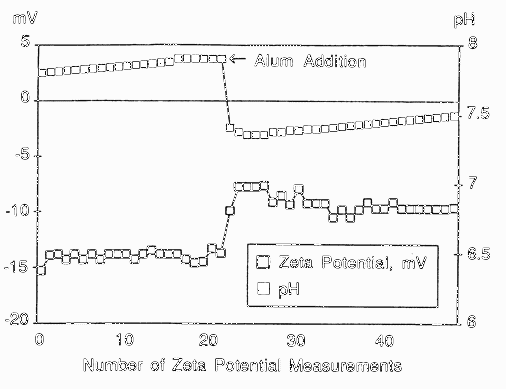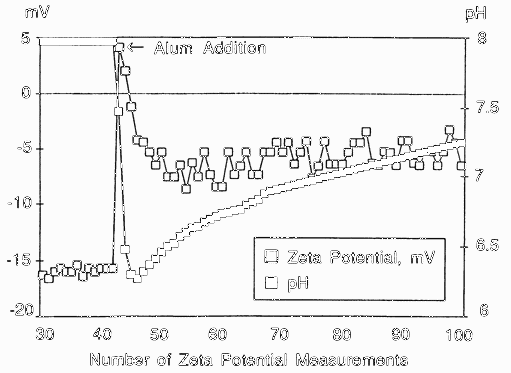

At the TAPPI Papermakers Conference (reported on p. 9 of the May issue), Max Laufmam said that about 38% of coated groundwood paper in Europe was produced under neutral or pseudo-neutral conditions. The glossary for the May issue, however, did not include the word "pseudo-neutral" because no written definition could be found. The word was too new.
John Penniman, president of Paper Chemistry Laboratory (Carmel, NY, 917/278-9000) has kindly sent in the following definition to clarify the concept for readers.
A new phrase, "pseudo-neutral," has entered the lexicon of the wet end chemist. It consists of the continuous addition of alum to an alkaline process at a usage level in the range of 0.5-1.5% The alum is added after the deaeration process and before the headbox at a point where uniform distribution can be assured. The effect is to temporarily depress the headbox pH and confer a positive charge which is effective in charge neutralization at the headbox.
Graph 1 shows what happens in the laboratory when 0.5%, or 10 lb/ton, of alum is added to a 50:50 blend of hardwood and softwood containing 25% calcium carbonate.
Fifty liters of 1%. consistency furnish is circulated from a holding vessel through the automatic/on-line zeta potential instrument, which makes zeta potential measurements approximately once per minute. A pH sensor is immersed in the holding vessel. After about 21 minutes, alum is added. The pH drops from 7.8 to about 7.4 and the zeta potential drops from -14 mV to -8 mV.
The disadvantage of the "pseudo-neutral" process is that the pH can be locally depressed below the critical pH of 6.5, which tends to dissolve the calcium carbonate, thereby causing foaming and the potential for both inorganic and organic deposits. This effect is illustrated in Graph 2, in which 1.5%, or 30 lb/ton, of alum is added. The pH drops from 8 to 6.2, and the zeta potential goes from -16 mV to +4. Both the pH and the zeta potential changes are very large effects.
The phrase "Pseudo-neutral" originated in Europe in the mid-eighties and was first used in connection with a calcium carbonate/groundwood process.
Graph 1. 50:50 HWD:SWD bleached kraft plus 25% calcium carbonate; the effect of 10 lb/ton alum addition on Zeta Potential and pH

Graph 2. 50:50 HWD:SWD bleached kraft plus 25% calcium carbonate; the effect of 30 lb/ton alum addition on Zeta Potential and pH
